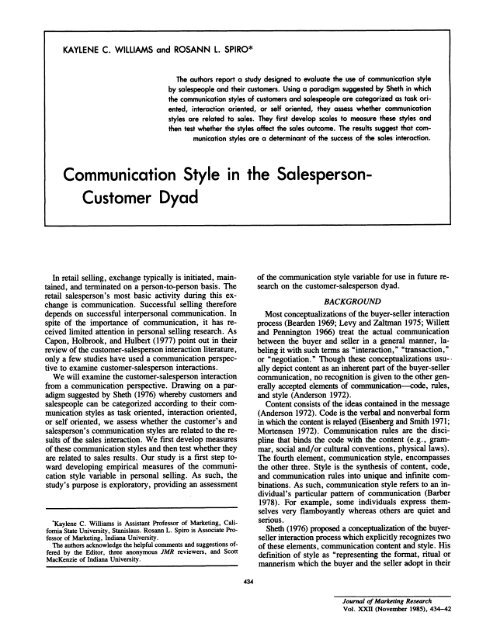Communication Style in the Salesperson-Customer Dyad
Communication Style in the Salesperson-Customer Dyad
Communication Style in the Salesperson-Customer Dyad
Create successful ePaper yourself
Turn your PDF publications into a flip-book with our unique Google optimized e-Paper software.
KAYLENE C. WILLIAMS and ROSANN L. SPIRO*<br />
The authors report a study designed to evaluate <strong>the</strong> use of communication style<br />
by salAspeople and <strong>the</strong>ir customers. Us<strong>in</strong>g a paradigm suggested by Sheth <strong>in</strong> which<br />
<strong>the</strong> communication styles of customers and salpspeople are categorized as task oriented,<br />
<strong>in</strong>teraction oriented, or self oriented, <strong>the</strong>y assess whe<strong>the</strong>r communication<br />
styles are related to sales. They first develop scales to measure <strong>the</strong>se styles and<br />
<strong>the</strong>n test whe<strong>the</strong>r <strong>the</strong> styles affect <strong>the</strong> sales outcome. The results suggest that communication<br />
styles are a determ<strong>in</strong>ant of <strong>the</strong> success of <strong>the</strong> sales <strong>in</strong>teraction.<br />
<strong>Communication</strong> <strong>Style</strong> <strong>in</strong> <strong>the</strong> <strong>Salesperson</strong>-<br />
<strong>Customer</strong> <strong>Dyad</strong><br />
In retail sell<strong>in</strong>g, exchange typically is <strong>in</strong>itiated, ma<strong>in</strong>ta<strong>in</strong>ed,<br />
and term<strong>in</strong>ated on a person-to-person basis. The<br />
retail salesperson's most basic activity dur<strong>in</strong>g this exchange<br />
is communication. Successful sell<strong>in</strong>g <strong>the</strong>refore<br />
depends on successful <strong>in</strong>terpersonal communication. In<br />
spite of <strong>the</strong> importance of communication, it has received<br />
limited attention <strong>in</strong> personal sell<strong>in</strong>g research. As<br />
Capon, Holbrook, and Hulbert (1977) po<strong>in</strong>t out <strong>in</strong> <strong>the</strong>ir<br />
review of <strong>the</strong> customer-salesperson <strong>in</strong>teraction literature,<br />
only a few studies have used a communication perspective<br />
to exam<strong>in</strong>e customer-salesperson <strong>in</strong>teractions.<br />
We will exam<strong>in</strong>e <strong>the</strong> customer-salesperson <strong>in</strong>teraction<br />
from a communication perspective. Draw<strong>in</strong>g on a paradigm<br />
suggested by Sheth (1976) whereby customers and<br />
salespeople can be categorized accord<strong>in</strong>g to <strong>the</strong>ir communication<br />
styles as task oriented, <strong>in</strong>teraction oriented,<br />
or self oriented, we assess whe<strong>the</strong>r <strong>the</strong> customer's and<br />
salesperson's communication styles are related to <strong>the</strong> results<br />
of <strong>the</strong> sales <strong>in</strong>teraction. We first develop measures<br />
of <strong>the</strong>se communication styles and <strong>the</strong>n test whe<strong>the</strong>r <strong>the</strong>y<br />
are related to sales results. Our study is a first step toward<br />
develop<strong>in</strong>g empirical measures of <strong>the</strong> communication<br />
style variable <strong>in</strong> personal sell<strong>in</strong>g. As such, <strong>the</strong><br />
study's purpose is exploratory, provid<strong>in</strong>g an assessment<br />
*Kaylene C. Williams is Assistant Professor of Market<strong>in</strong>g, California<br />
State University, Stanislaus. Rosann L. Spiro is Associate Professor<br />
of Market<strong>in</strong>g, Indiana University.<br />
The authors acknowledge <strong>the</strong> helpful comments and suggestions offered<br />
by <strong>the</strong> Editor, three anonymous JMR reviewers, and Scott<br />
MacKenzie of Indiana University.<br />
l~~<br />
~~~~~~~~~~~~~~~~~~~~~~~~~~~~~~<br />
~~<br />
434<br />
of <strong>the</strong> communication style variable for use <strong>in</strong> future research<br />
on <strong>the</strong> customer-salesperson dyad.<br />
BACKGROUND<br />
Most conceptualizations of <strong>the</strong> buyer-seller <strong>in</strong>teraction<br />
process (Bearden 1969; Levy and Zaltman 1975; Willett<br />
and Penn<strong>in</strong>gton 1966) treat <strong>the</strong> actual communication<br />
between <strong>the</strong> buyer and seller <strong>in</strong> a general manner, label<strong>in</strong>g<br />
it with such terms as "<strong>in</strong>teraction," "transaction,"<br />
or "negotiation." Though <strong>the</strong>se conceptualizations usu-ally<br />
depict content as an <strong>in</strong>herent part of <strong>the</strong> buyer-seller<br />
communication, no recognition is given to <strong>the</strong> o<strong>the</strong>r generally<br />
accepted elements of communication-code, rules,<br />
and style (Anderson 1972).<br />
Content consists of <strong>the</strong> ideas conta<strong>in</strong>ed <strong>in</strong> <strong>the</strong> message<br />
(Anderson 1972). Code is <strong>the</strong> verbal and nonverbal form<br />
<strong>in</strong> which <strong>the</strong> content is relayed (Eisenberg and Smith 1971;<br />
Mortensen 1972). <strong>Communication</strong> rules are <strong>the</strong> discipl<strong>in</strong>e<br />
that b<strong>in</strong>ds <strong>the</strong> code with <strong>the</strong> content (e.g., grammar,<br />
social and/or cultural conventions, physical laws).<br />
The fourth element, communication style, encompasses<br />
<strong>the</strong> o<strong>the</strong>r three. <strong>Style</strong> is <strong>the</strong> syn<strong>the</strong>sis of content, code,<br />
and communication rules <strong>in</strong>to unique and <strong>in</strong>f<strong>in</strong>ite comb<strong>in</strong>ations.<br />
As such, communication style refers to an <strong>in</strong>dividual's<br />
particular pattern of communication (Barber<br />
1978). For example, some <strong>in</strong>dividuals express <strong>the</strong>mselves<br />
very flamboyantly whereas o<strong>the</strong>rs are quiet and<br />
serious.<br />
Sheth (1976) proposed a conceptuali7ation of <strong>the</strong> buyerseller<br />
<strong>in</strong>teraction process which explicitly recognizes two<br />
of <strong>the</strong>se elements, communication content and style. His<br />
def<strong>in</strong>ition of style as "represent<strong>in</strong>g <strong>the</strong> format, ritual or<br />
mannerism which <strong>the</strong> buyer and <strong>the</strong> seller adopt <strong>in</strong> <strong>the</strong>ir<br />
Journal of Market<strong>in</strong>g Research<br />
Vol. XXII (November 1985), 434-42

















